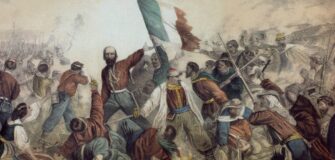Dal quotidiano “THE GUARDIAN”: How febrile online rumours were fed by inept palace PR
Share
Esther Addley Lucy Mangan diary
On Tuesday, as the crisis in Gaza continued, turmoil built in Haiti and Joe Biden and Donald Trump were being confirmed as their parties’ presidential candidates, the White House press secretary was asked a question by a journalist that caused her, briefly, to laugh.
“Does the White House ever digitally alter photos of the president?” Karine Jean-Pierre was asked. “Why would we digitally alter photos? Are you comparing us to what is going on in the UK?” she said. “No – that is not something that we do here.”
When Kensington Palace released an apparently candid photograph last weekend of the Princess of Wales and her children, timed to coincide with Mother’s Day, it no doubt expected the usual warm reception, perhaps with a few approving front pages.
One week on, things have not gone to plan. After multiple clumsy edits to the photo were identified, five leading photo agencies issued a “kill notice” of the “manipulated” image. Since then, large sections of the world’s media have been fascinated by the photograph – and what it may say about unwell Catherine – putting the royals at the centre of a crisis of credibility.
In Spain, some outlets have doubled down on claims, rubbished by the palace last month, that the princess is in a coma. On US talkshows, longstanding, libellous rumours about the royal marriage, similarly denied, are being aired in the open.
On social media, the unfounded conspiracies are wilder still.
Catherine has had a facelift, or she is in hiding, or has been replaced by a body double. Most are easy to dismiss, but when ITV’s royal editor, Chris Ship, one of the select handful of “royal rota” journalists who are briefed by the palace, posts a tweet that begins, “I’ve never been much of a conspiracy theorist but …”, the royal family undeniably has a problem.
Who would be a royal? According to the palace, the mother of three has undergone abdominal surgery and is not well enough to appear in public. When the operation was revealed on 17 January, Kensington Palace said she was not expected to make any public appearances until at least Easter. That, they say, hasn’t changed. So why the frenzied conspiracies?
Perhaps because Catherine, 42, remains media catnip, and is enormously important to the royal public image. Things would arguably have been more manageable, however, were it not for the unhappy coincidence of King Charles’s announcements of his prostate treatment and cancer.
While the princess had requested privacy over her diagnosis, the king and his (separate) Buckingham Palace press team opted to be more open about his prostate problem – though the form of his cancer has not been revealed. Most people were happy to accept this as the princess’s right. And yet the fact that the king has remained somewhat visible, even while undergoing cancer treatment, made the silence from Catherine more evident.
What tipped online mutterings into febrile speculation was when the Prince of Wales pulled out of the funeral of his godfather on 27 February citing a “personal matter”. The Mother’s Day photo was an attempt to settle the mood; instead, its inept handling turned an uncomfortable drama into a fullblown crisis.
Even a brief apology, signed in Catherine’s name, did not help. Either palace advisors had not grasped the gravity of their mistake or the royal couple, so protective of their children’s privacy, were resisting their guidance.
Can they recover from it? Only if they change tack, said Emma Streets, associate director at the communications agency Tigerbond, who specialises in crisis PR. There remains a lot of empathy towards the princess, she said, and “I think [the episode] proves that she’s only human. But it’s crucial that the palace do not repeat a [mistake] on this scale.”
They will have to provide an update on the princess’s health by Easter, she said, whether or not Catherine is well enough to resume normal public appearances. “I think they really need to maintain that timeline to avoid any further controversy. So the pressure is on for the comms team to handle that without putting a foot wrong, and really, meticulously, plan.”
More broadly, she said: “Their legacy strategy of ‘never complain, never explain’ is obviously outdated. That doesn’t work today, given the speed that this story will spread online, and I think that massively needs addressing from a strategic point of view.”
That view is echoed by Lynn Carratt, head of talent at digital and SEO specialists Press Box PR, who said she was “racking her brains” why Kensington Palace did not release the undoctored image: “They could have put this to bed straight away.
“There needs to be an overhaul of their comms strategy and a bit of honesty and trust with the press,” she said. “I kind of understand why there isn’t – but they need a whole new approach to PR, to bring it into the modern world of the media. We’re not just talking about print press and broadcast, when it’s now social media and the digital space where people are consuming the news. It’s very different, and you need to do PR differently for that space.”
You’ve seen the factbased drama. Do you really need to watch the accompanying documentary as well? Sometimes it’s the other way round, and there’s a documentary that makes a scripted drama on the same subject redundant. Either way, the drama/doc double-up is here to stay, because it makes sense for TV channels to hedge their bets. In the increasingly cash-strapped world of British telly, it can save money: get the same production company to share one team of researchers.
Counting pennies is probably not the motivation behind The Bloody Hundredth, an hour-long documentary made for Apple TV+ by companies belonging to Steven Spielberg and Tom Hanks. This is the factual version of Masters of the Air, the same team’s lavish ninepart drama about the 100th Bomb Group, a gang of daring US airmen who helped to win the second world war.
With Hanks narrating and Spielberg as a contributor, The Bloody Hundredth is a high-quality production, but it’s like a DVD extra, a whip of cream on the top of the sumptuous Masters pie. It assumes you’ve already seen Masters of the Air. You should indeed watch it first, because while this is a perfectly decent summary of the story, it can’t muster the same romance or spectacle.
If you have seen Masters of the Air, The Bloody Hundredth chiefly acts as a way of confirming that yes, all of that did happen. Stationed in Norfolk for the last two years of the war, the 100th carried out bombing raids on infrastructure in occupied Europe and Germany itself, taking huge casualties as the Nazis’ air defences fired back. The raids were so harrowing that shellshocked men actually were regularly packed off to a country house near Oxford for afternoon tea and croquet, to soften what was politely called “combat fatigue”.
The Bloody Hundredth boasts an impressive amount of contemporary film footage, demonstrating that Masters of the Air looks exactly right too. There is the airfield at Thorpe Abbotts, with mechanics and commanding officers nervously looking out across flat green fields, hoping their boys will reappear on the horizon. Here is the officers’ bar, with its industrial-tinged speakeasy chic. We are up in the air as well, peering through the famed Norden bombsight at exploding German factories miles below us, or flinching as another shrapnelpacked anti-aircraft shell explodes nearby in a puff of black smoke.
Sometimes it’s distractingly unclear exactly what we’re watching: as we hear about a particular Luftwaffe attack or a specific member of the Bloody Hundredth being shot down, surely the pictures we’re seeing can’t be of those events exactly? Or can they?
Masters of the Air has done a superb job of keeping the heroes of the 100th Bomb Group alive and, at around nine times longer than The Bloody Hundredth, it fares better than this sometimes rushed documentary at marshalling a narrative that morphs from flyingace drama to behind-enemy-lines thriller to tense prisoner-of-war saga. In this instance, what really happened has the twists and the grand sweep of epic fiction; actors with sets and scripts are better placed to keep telling the story.













